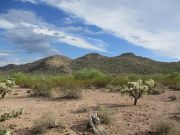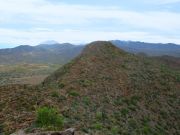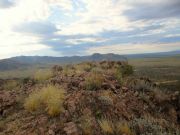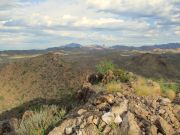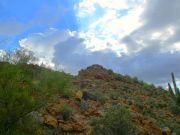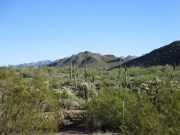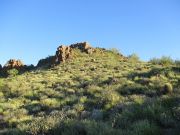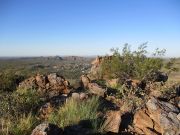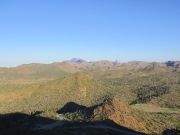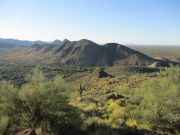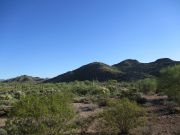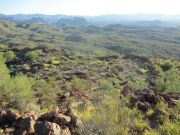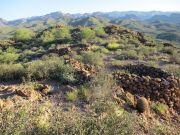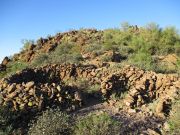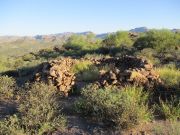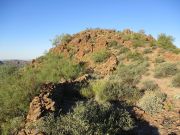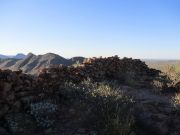
The Mountains of Arizona
www.surgent.net |
|
Comet Peak • Quebec Rock & Queen Valley Ruins Comet Peak and Quebec Rock rises north of US-60, on the stretch east of Florence Junction and before the highway rises toward the hills near Superior. The two peaks form anchors for the Whitlow Dam, an earthen dam put in to hem the occasional floodwaters of Queen Creek, a major drainage that comes down from the highlands to the east. The community of Queen Valley lies below the dam, to the west. I was here twice in a week. I came here first to climb Comet Peak, and wasn't that interested in Quebec Rock. I was successful on Comet Peak, and made a half-hearted effort to "climb" Quebec Rock, but I gave up while still on the dirt access road. That day was supposed to get stormy (and it did), so I returned to my car and drove home. Researching all this later, I learned that there are some interesting rock wall battlements from the ancient Indians of the region. I was not aware of this beforehand, and suddenly, I wanted to climb Quebec Rock and check out these stone walls. Thus, I returned here, less than a week later. This time, the weather was lovely, with blue skies and no clouds.
Date: October 15, 2022
• Elevation: 2,691 feet
• Prominence: 491 feet
• Distance: 2 miles
• Time: 2 hours
• Gain: 550 feet
• Conditions: Mostly cloudy, some sun
Arizona
•
Main
•
PB
•
LoJ
I was on the road a little after 6 a.m., driving east on US-60 through Apache Junction and through Florence Junction. The sun was rising and blinding me at times, but clouds to the east would block it out for minutes at a time. I drove through one gentle shower along the way.
I eased off US-60 onto Queen Valley Road, which runs below the peak and leads to the small community of Queen Valley. My first plan was to explore the Hewitt Station Road, which branches off of Queen Valley Road and runs south then east of the peak. But this was a non-starter immediately. The whole area is the domain of target shooters. So I turned around and looked for a western approach.
I parked in a clearing along Queen Valley Road. I don't like to be right along a road, but I had no choice. Conditions were pleasant, temperature about 70 degrees and a little humid given the clouds, but not uncomfortable. I eyeballed a possible route to the top. A southern approach did not look promising at all, too many cliffs. A northern approach looked better.
I first had to shimmy underneath a fence. Past that, I walked on a beeline toward the base of a ridge emanating off the mountain. It looked good so I started up it, and soon, was on its crest. I followed it through one rocky segment, then down about 40 feet to a gentle saddle. I then started up the other side but angled right. This put me in the saddle between the first and second of the two lower summits. So far, so good. I had no problems, the rock was solid, the brush spaced out and no obstacles to get around.
I then started up the slopes to the second peak (the middle of the three, the highpoint being "peak 3" to the south). It was steep, but there were no cliffs. The rock mainly fractured into piles so that I could zig and zag and always find an easy ramp or chute through the rocky jumbles. I did not use my hands at all except for balance a couple times. I was soon on the second peak's summit (a bonus peak, I suppose, prom about 80 feet). The summit had wooden planks and other items from past surveyors. Also, now this high, I could see and hear the shooters down below. They were going to town, one shot after another, punctuated occasionally by rapid fire and sometimes by a loud boom. I was high enough to not be worried.
On this second summit, I looked over at the highpoint, which rises about 30 feet higher. Suddenly, it didn't look so easy. There was a rocky prow blocking the most logical route. But I wasn't giving up. I'd get there and see first.
Descending the second summit, I had to maneuver carefully. The rock here was steeper and the slopes a little loose. None of it was exposed, but I had to pay attention. More than once I backed off one line and tried another. But in time, I was at the saddle below the second and highpoint summits. The echos of the bullets play tricks on the senses. Everything sounds like it's coming from the next peak over. It really sounds like they're shooting at the peak itself. I knew this was not so, but the continuous din of fire from the shooters never ceased. If anything, it just made them more enthusiastic.
I hiked steeply up to that rocky prow/cliff/gendarme thing. From a distance, it looked like potential trouble, but I know Arizona well enough that in this kind of rock, it usually fractures so that there is always some messy climbable option to get around an actual cliff. I ended up tacking left slightly, working up a twenty-foot series of small ledges and chutes, this being the only part that I needed hands for the actual climbing. I'd rate it Class 2+/3-. Once above this, I was happy to see the summit was mere yards away. I walked to it, and took a moment to appreciate that I got up the stupid thing.
There is a corner-marker benchmark on the summit, leaning to one side and too scratched to read. The map shows a benchmark icon, but I could not find such a benchmark, unless they were counting this as it. The register featured scraps of paper from the 1990s, and a newer Lilley-MacLeod pad of paper. The last person to sign in was in 2018, and it appeared not many people climb this peak, less than one group a year. Some appeared to be clubs, so that a half-dozen would sign at once.
I had some sun for the moment so I shot some images. The best view was north, looking at the main cluster of peaks and spires of the Superstition Mountains, with Weavers Needle jutting above the hills in the distance. I had a breeze, but I did not linger much. I got what I came for and wanted to start down while I remembered what I did coming up. And at no time did the shooting ever slow down. The most confusing ones were the big "booms". It's an odd feeling to be hiking amid so much gunfire, but this is not the first time I've done this. I just put it out of my mind.
Rather than retrace my route back up over and down the second summit. I decided to just bail off the saddle and into the drainage directly, forming a loop hike. The downclimb to the saddle went well. I followed a different ledge-chute combination down, which worked well. It was no worse nor better than the one I took going up. Once at the saddle, I eased downslope into the drainage, then poked my way through the brush and rocks until things started to open up. I was soon back to the flats west of the peak, and back to my car. I had been gone 2 hours. The sun came out again and I was able to take better photos.
I was a little more jazzed than usual with my success on this peak. The route-finding and the low-end scrambles kept me engaged better and I enjoyed it very much. I may suggest to future visitors to follow in the drainage I took on the way out. Its headwall is below the saddle connecting the second and highpoint summits.
I next drove into Queen Valley, following the roads to where a dirt road then branches east toward Quebec Rock, the other peak that anchors the Whitlow Dam. The dam itself was built in 1960 by the Army Corps of Engineers. The are signs on the roads barring unauthorized vehicles and other forms of activity, but nothing saying no hiking is allowed. I parked in an open spot and started walking toward Quebec Rock, and just as fast, called it. I wasn't that interested, and I figured I should be getting back to Tempe sooner than later.
I was back in town by 11 a.m., and the storms they were forecasting came rushing through, three or four big downpours and lots of lightning. October is usually very dry, so these kind of storms are rare.
Date: October 21, 2022
• Elevation: 2,596 feet
• Prominence: 396 feet
• Distance: 1.4 miles
• Time: 90 minutes
• Gain: 550 feet
• Conditions: Blue skies and pleasant
PB
•
LoJ
I left home a little before 6 a.m., the eastern sky barely lighting up. I got onto eastbound US-60, where traffic was steady but not slow, since most people are heading into Phoenix westbound. In roughly 45 minutes, I was in Queen Valley and located myself to the same parking spot I used last week, at a corner of two dirt roads, where one heads northeast and circles around Quebec Rock. I got properly attired and started walking at 6:50 a.m., the sun now up but still with long shadows on the western-facing slopes. The sky was blue and clear, temperature about 65 degrees.
The sign at the corner of these roads prohibits "unauthorized" vehicles and other forms of access but does not explicity forbid foot traffic. The land here is State Trust, and on the summit and the eastern flanks, a narrow band of BLM land. The road leads to an old gravel mine where shooters like to go, and continues presumably to the backside of the dam. I saw a couple work trucks drive up as I hiked and they didn't say boo. Later, I saw two women out for a walk on this road, so I take it that access is unofficially okay, as long as one behaves.
I hiked up the road a little bit, past one low foreground hill. I was eyeballing a way up and saw a long steep ramp on the peak's southwest face, slightly right of the summit rocks. This looked promising so I aimed for it. Once off the road, I had to cross a few arroyos, hiking against the grain of the arroyos. They were easy to cross but with steep and loose sides.
Once past the arroyos, I was now on a straight-shot toward this ramp. As the grade steepened, the terrain becase brushier mainly with shin-high grass clumps and lots of rocks. There were no trees and very little cactus, just a lot of this grass. The rocks were often loose, so the uphill went slow as I had to move carefully, but it was not difficult. To ease the gradient, I zigged and zagged slightly. Soon, I was on the top ridge, slightly southeast of the summit.
The last segment to the top was a tad rockier but not as steep, and I used hands a couple times mainly for balance. The summit is flat with a few rock outcrops, the summit rock plainly obvious. On it was heaped smaller rocks. I looked for a register but didn't find it. There was a smashed mirror on the ground. Looking later on HikeArizona, visitors from 2018 mentioned the register and two intact mirrors. Someone likely took the register and smashed the mirrors. The only other source of information I had to go by were the comments on the All-Trails site, but none mentioned the summit with any detail.
Now for the ruins. These lie below the peak, on a flat bench about 50 feet down the east face. The bench itself looks to be about a hundred feet wide, roughly circular. Low walls about 4 feet high surround this perch, and within the walls are a handful of circular structures with smaller subrooms. These walls looked solid, no apparent degradation other than by natural forces over the centuries. I'm not an expert in archaeology, but my opinion is that this looked like a fortification or observation perch (or both), not a long-term village. It looks too small to be a village site, and the walls surrounding the perch would suggest it was for protection or for cover. The walls are many centuries old. I merely walked around and snapped photos. I did not paw at the rocks or move anything. The rule for ruins is always keep the hands off.
I stuck around the area for about 15 minutes. The views were tremendous. Superstition Peak and Weavers Needle rose to the northwest, Picketpost Mountain to the east, Comet Peak to the southeast, and hundreds of hills and ridges in all directions. I could see Newman Peak way off to the southwest. With the sun up, the temperature was into the 70s, and with a soft breeze, was very comfortable.
I followed the same ramp downhill, moving slow because every third rock wanted to roll. I kicked a few loose and almost rolled along with some, but somehow remained upright. The outbound hike took a half hour, and I was back to my car at 8:20, a 90-minute hike. I did not hike far, only 0.7 mile each way. I was back "home" before 10 a.m.
The name of the peak is taken from the Peakbagger and ListsofJohn sites and a couple references from the HikeArizona sites, but I do not know why it gets called Quebec Rock. If anyone knows, drop me an email because I am curious. I cannot even begin to guess, as there is no apparent theme out here that would suggest this name (e.g. an old mine, other features with similar names). It's Arizona's special homage to our friends up north and east. Any ruins one encounters should always be treated respectfully and never disassembled or otherwise changed. Keep the hands to your side. It fascinates me to see these ruins which may date 500-700 years in age, and still they look like they were constructed recently. These are tangible connections to the distant past. These particular ruins require a hike that many people may not want to do, which helps explain why these ruins look so good for their age. |
|
